The history of the hair dryer

However, although it is very handy in its current form, that was not always the case. The hair dryer had to undergo quite a few changes over the years before emerging as the small, lightweight, ergonomic and compact device we all know!
Inspired by the vacuum cleaner
The device whose primary function is to blow hot (or cold) air to accelerate the water evaporation process and effectively dry hair was invented in the late 19th century by French hairdresser and inventor Alexandre-Ferdinand Godefroy. Known as the “séchoir” (dryer) at the time, the device which was halfway between a vacuum cleaner and a hair dryer comprised a sort of long cap connected to a flexible hose that projected hot air from a gas stove onto the wearer’s hair! It was not portable in the least – and it is easy to see why – and was only used in hairdressing salons frequented by a posh and urban clientele.
Birth of the “hot and cold air shower”
Godefroy’s invention inspired many tinkerers to develop drying machines each more bizarre and worrying than the last. In the 1920s, hand dryers comprising a heating element and a fan first began to appear. The first manual electric model was invented in 1926 by an engineer working for the Calor company, Léon Thouillet. It was called the “hot and cold air shower” and it was initially used in healthcare: for applying heat to painful areas and cauterizing wounds. It was also used to heat beds and shoes, to defrost food, to warm up children, and more.
Portable but so heavy…
The very first portable “dryers” were made from metal and initially fitted with a wooden handle, later replaced with Bakelite. They were very heavy, weighing close to 1 kg, and were difficult to use. Their electrical connections were not always very safe and ended up causing a number of, sometimes fatal, accidents involving overheating and electrocution. The airflow created by the machines was very weak, given their 100-watt capacity – and the women who tested the first models were often exhausted well before their hair had dried!
Until the late 50s, the main improvements made to hair dryers focused on increasing its power, and the mechanism itself – a motor driving a blower device and an electrical resistance, so that the air flowing into one side is heated when pushed out the other – did not see any major improvements. Its external appearance, pistol-shaped for easy handling, also remained almost unchanged.
Lightweight, safe and cheerful
The hair dryer took off as a commodity in the 60s, when the metal was substituted for plastic, mainly ABS.
It was made lighter, safer, insulated against heat, more affordable, available in any colour, shape and design. In short, it was made accessible to all and became a common feature in every household.
Some of them have even become collectors’ items, like the model launched by Moulinex in 1968, whose appearance is reminiscent of an electric drill, and whose “Clémentine” version was made in orange, the trendiest Pop colour of the time.





